Enter the realm of simplified integration with the Global Webhook, a powerful platform designed and developed by SurveySparrow, enabling users to harness SurveySparrow events and seamlessly notify other applications. This marks a significant stride towards automation excellence.
Event - An event can be defined as a change of state. It is used to notify someone that something has happened.
For example, the creation of a contact can be considered an event, and receiving a response to a survey can be considered a submission event.
The purpose of Global Webhook is to streamline the process of data retrieval from SurveySparrow to other applications. This removes the unnecessary overhead of repeatedly making API calls to SurveySparrow.
What will you learn?
In this tutorial, you will gain an in-depth practical understanding of Global Webhook by creating one yourself. Below are the topics covered in this tutorial.
- How do you set up an endpoint URL?
- How do you add authorization headers to ensure a secure transfer of data?
- Detailed explanations regarding all the encryption algorithms used to handle the authorization headers
- How do you securely handle the event payload?
Note: It is important to leverage all the various configurations and authorization procedures involved in creating the webhook.
Let's get started!!
As you know, the event payload is sent to an endpoint URL which you will provide when you create the webhook. The endpoint URL doesn't allow http endpoints.
Real-Time Scenerio
Imagine you have two online tools – SurveySparrow and a third party application. You want these tools to work seamlessly together. One best way to achieve this is through Global Webhook.
In this scenario, let's say SurveySparrow is where you collect information about your contacts. Whenever a new contact is created there, you want this information to be instantly sent to the third party application, keeping everything up-to-date.
Here's where the Global Webhook comes into play. You set up the endpoint URL (associated with the third party application) within SurveySparrow. Now, whenever a new contact is created in SurveySparrow, it sends an automatic message (event payload) to that endpoint URL.
The third party application is constantly listening at this endpoint URL. As soon as it receives the message, it knows to take action. In this case, it creates a new contact using the event payload on their database, sent from SurveySparrow.
This way, the two tools are in constant communication. Anytime a new contact appears in SurveySparrow, the third party application is immediately in the know and can update its records accordingly.
Let's get started with creating your first webhook!!
Let's locate the Webhooks in SurveySparrow.
- In your account, go to settings -> scroll down the left menu panel to find APPS AND INTEGRATIONS -> click on the Developer Portal
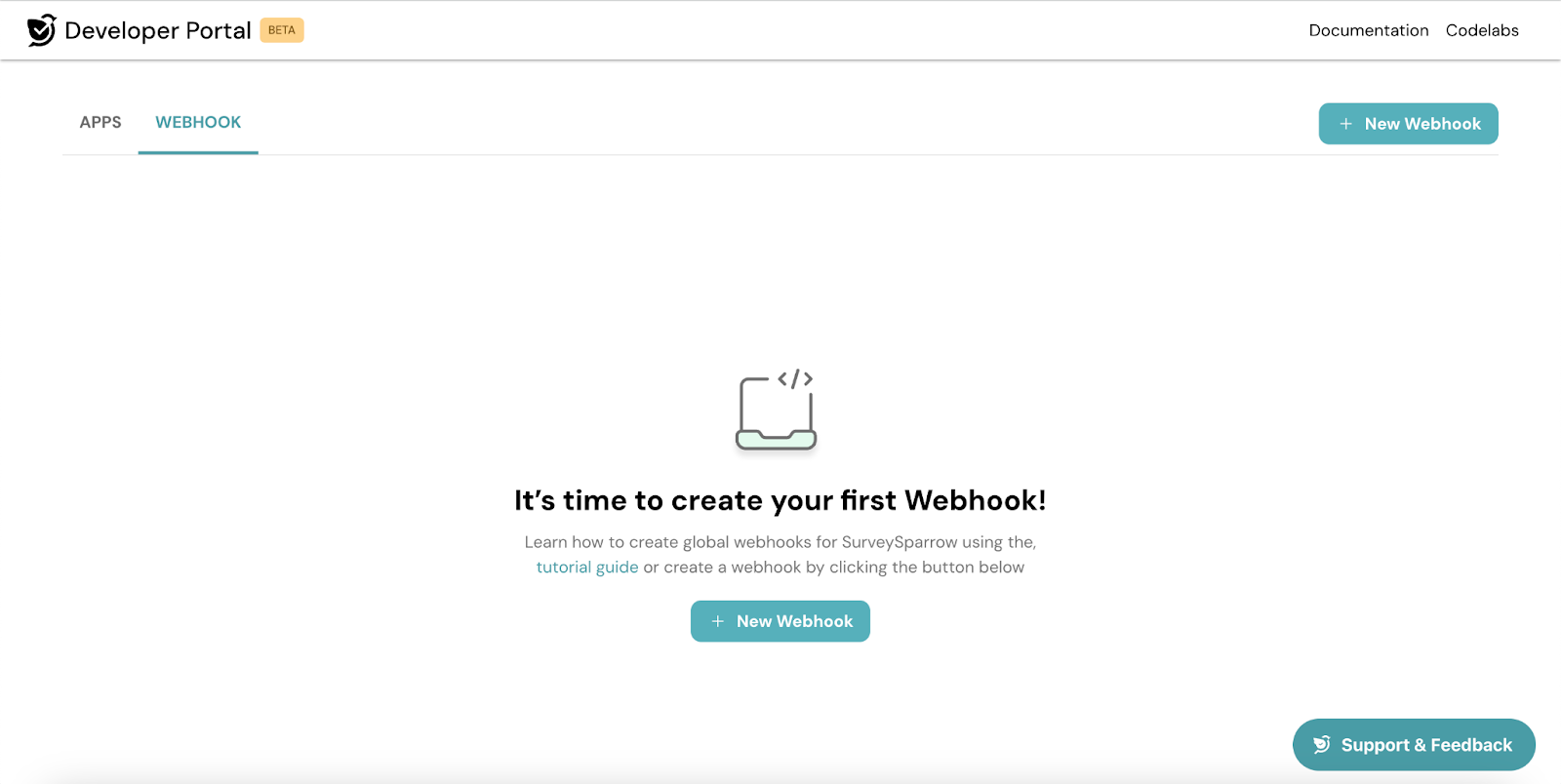
- Click on + New Webhook to create the webhook
You will find a list of required and optional fields. These fields are important to fill in and detailed explanations of the fields are down below.
- App Name - As the name suggests, you can provide an appropriate name that's relevant to the functionality you want to implement.
- Short Description - Here, it's highly useful to provide the necessary instructions, the purpose of this webhook app, unobvious configurations, and other important information.
- Support Email - This is crucial to specify because if the webhook you created is malfunctioning or if the endpoint URL throws errors for 24 hours, you will be notified via this email.
- Support URL (Optional) - Provide a support URL through which SurveySparrow's support team can contact you regarding any issues with your webhook app.
- Website Link (Optional) - Provide a website URL that you are associated with such as your company's website, personal website, etc. This is to verify the identity of the user who's creating the webhook app.
- App Icon (Optional) - Upload a suitable app icon that's minimalistic and relevant.
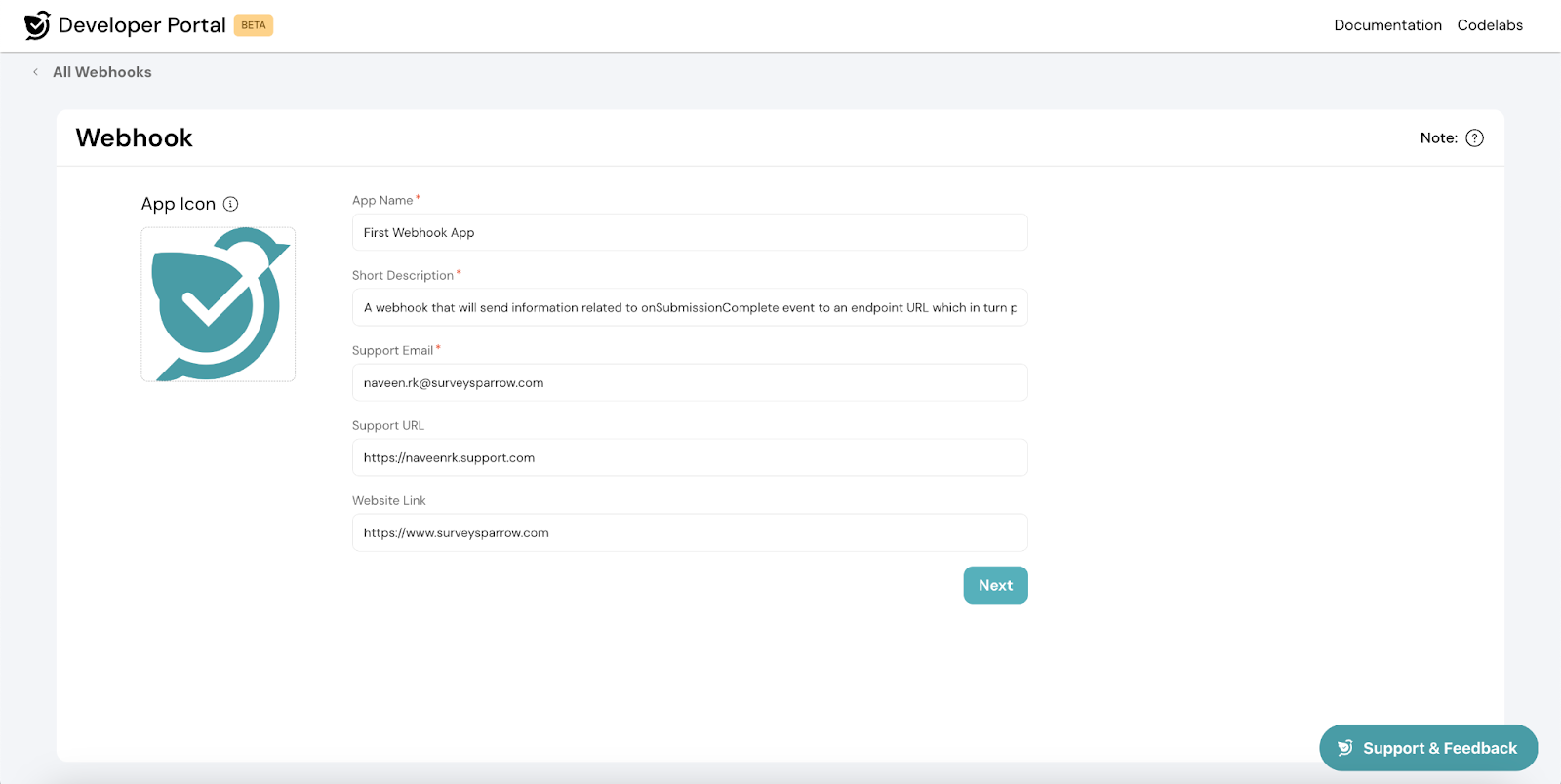

Secret Token
The secret token helps in the process of verifying that the event payload is sent from SurveySparrow to your server.
What happens behind the scenes?
- When the event gets triggered, the event payload will be sent to your server where extra key-value pairs will be passed in the headers. Find the reference to the request headers down below.
user-agent: SurveySparrow AppNest x-appnest-signature: ef1ee97cf88e42bb12c14f7885 authorization: Bearer eyJ0eXAi0iJKV1QiLCJub25jZSI6I traceid: e549501a-aa1c-4e45-9cea-9a0e05d7311b x-appnest-timestamp: 1705565839 - In the x-appnest-signature, there is a token encrypted with the help of event payload and the secret token in the webhook using the SHA384 algorithm.
- So, every time the event payload is sent to your server, you can validate this x-appnest-signature by encrypting the event payload with a secret token using the SHA384 algorithm. After that, you can check if both the encrypted tokens are the same.
- To encrypt it, first convert the payload(sent by SurveySparrow) place the secret token(visible in the webhook) in the salt field, and then compare it with the x-appnest-signature sent in the headers.
- This is an additional security measure to ensure that the event payload is sent from SurveySparrow.
Endpoint URL (POST Method)
Enter the URL to which SurveySparrow should send the event payload.
When the selected events get triggered, the webhook app will make a POST request to the endpoint URL where the event payload will be passed in the request body.
Next, click on the validate button to validate the URL.
To validate from your server, the platform expects the endpoint URL to return the status code of 200 and the content type as application/json.
HTTP/1.1 200 OK
Content-Type: application/json
This will allow SurveySparrow to check if the endpoint URL is valid.
Authentication Header (Optional)
This is where you can specify extra headers to the POST request. There is also an option to keep it default as well.
These extra headers provide added security to your webhook.
Basic Authentication
- This is one type of authentication where it requires a username and password to be sent with the headers.
- You can validate the username and password by accessing the headers in the endpoint URL you specified above.
How does basic authentication work?
- The username and password specified will be converted to this string-based form - "username:password"
- This string will be encrypted as a base64 string and then sent in the headers in the below format.
authorization:"Basic {encrypted_string}" - To validate this encrypted string, you can do so by encrypting the username and password on your server and then comparing them with the base64 string sent in the authorization headers.
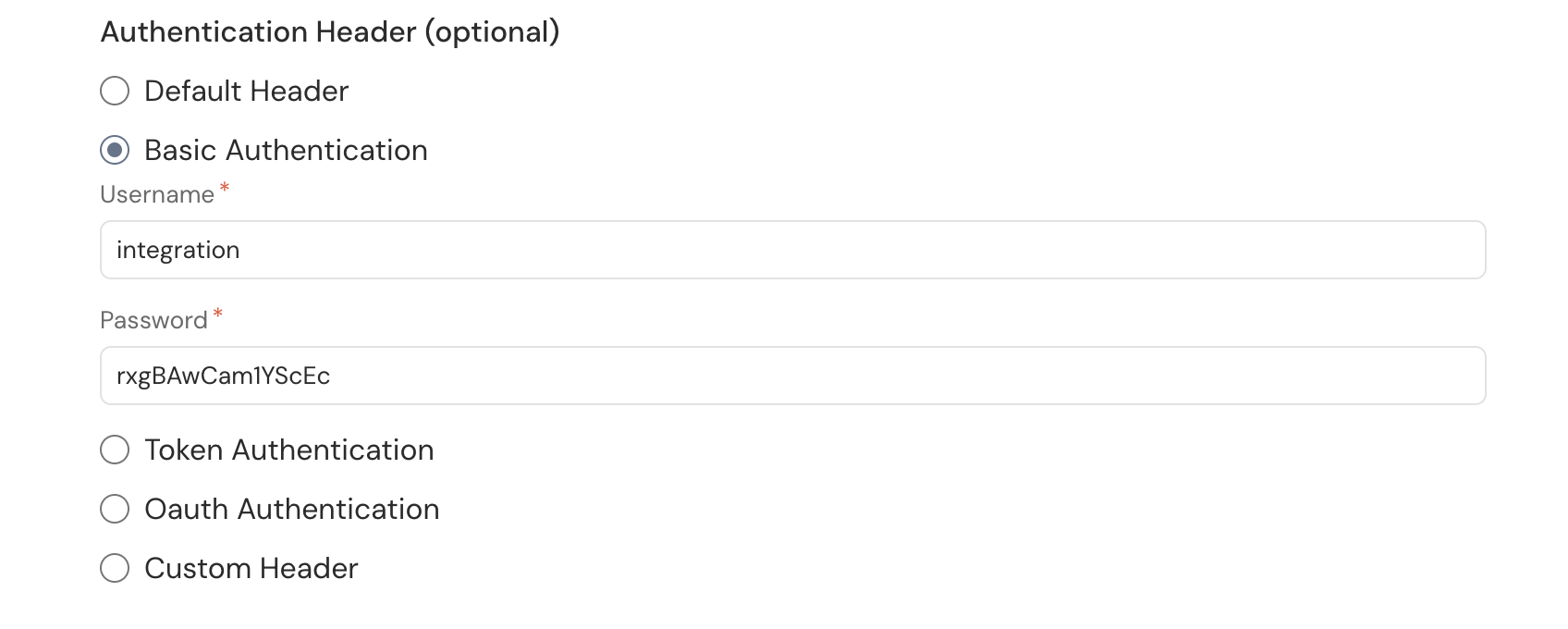
OAuth Authentication
- If the third party application needs oauth-based authentication, just specify the client ID, client secret, token URL and scope (optional) of the application.
- That is, third party should have an endpoint to handle this token URL which is responsible for sending access tokens.
- The webhook will first send a POST request to this token URL to fetch the access token on the initial event trigger.
- After fetching the access token, the webhook makes a POST request to the endpoint URL with the access token passed in the Authorization headers.
- If the access_token expires, the webhook sends another request to the same token URL and fetches the new access token.
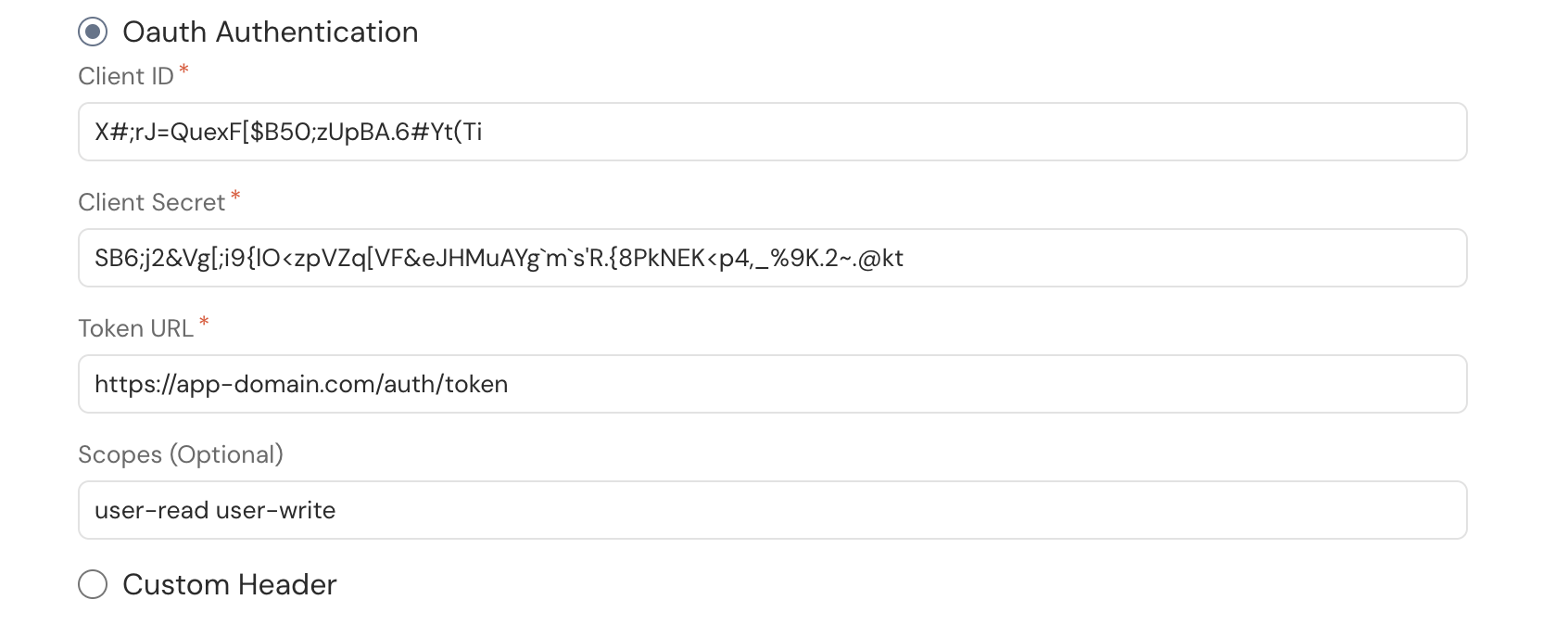
Token Authentication
- Token Authentication is quite similar to OAuth Authentication but here you can only specify the client ID, client secret, and token URL.
- Scope is not defined in Token Authentication
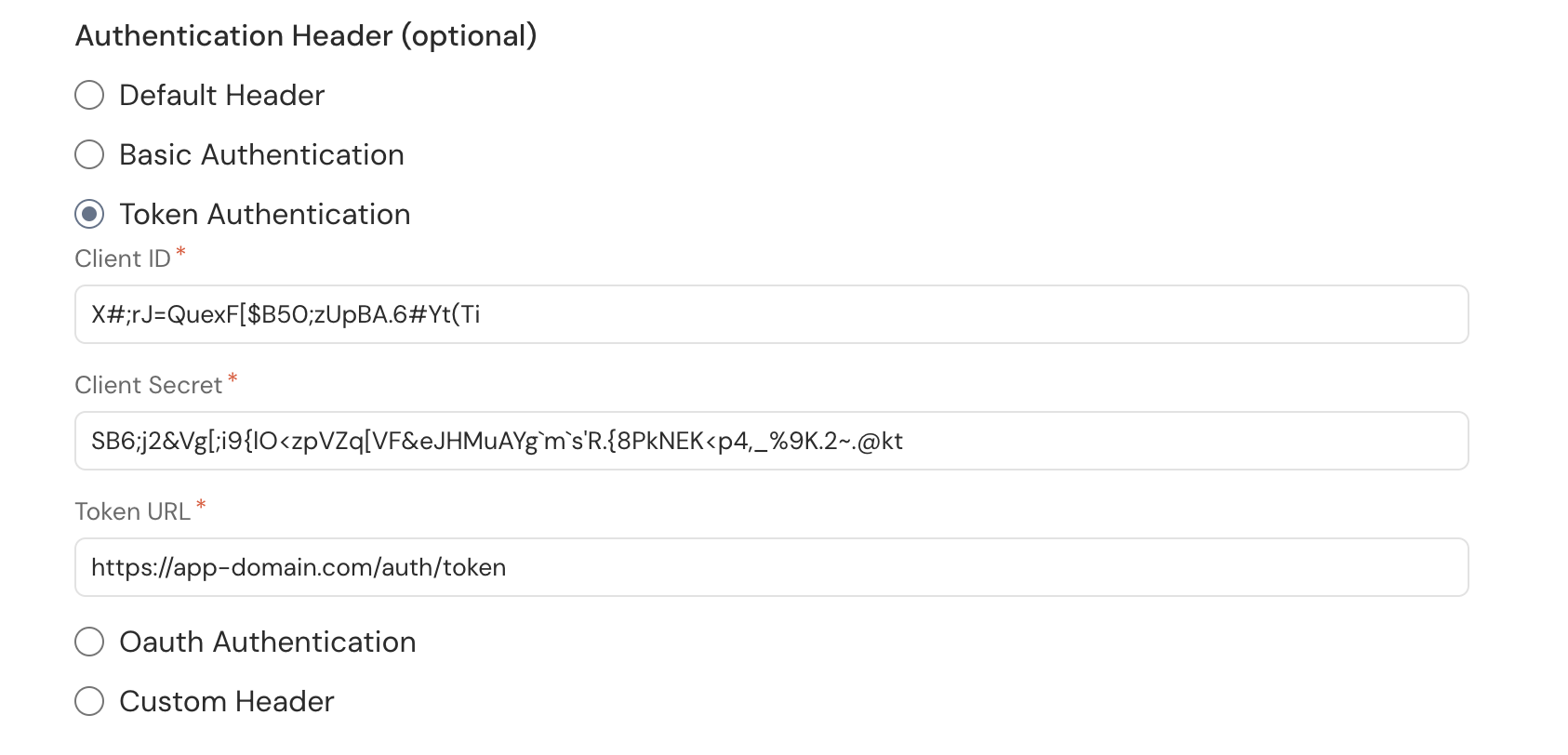
Note: In both Token Authentication and OAuth Authentication, the platform expects the token URL to return the response in the below format.
HTTP/1.1 200 OK
Content-Type: application/json
{
"access_token":"MTQ0NjJkZmQ5OTM2NDE1ZTZjNGZmZjI3",
"token_type":"Bearer/Basic",
"expires_in":3600,
}
Custom Headers
As the name suggests, it allows you to specify customized key-value pairs which you can send as part of the headers.
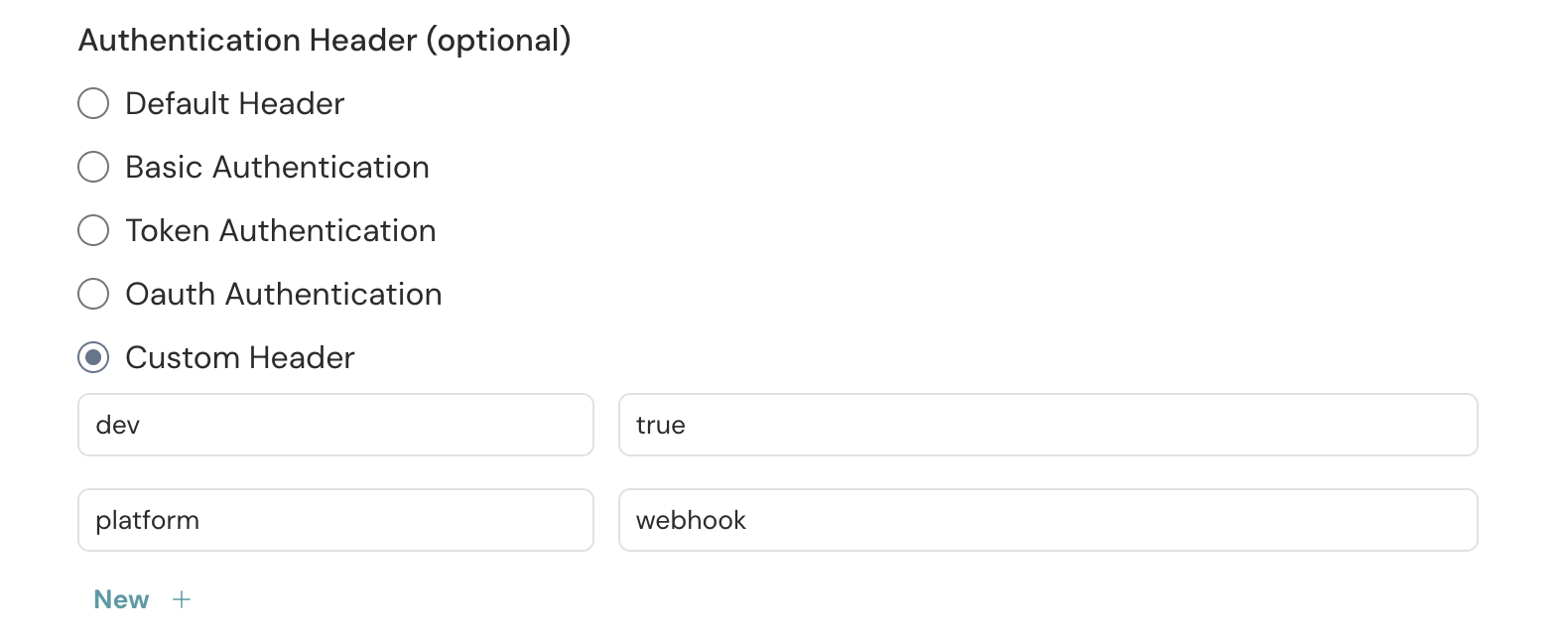

Here, you can select the events whose data you want to fetch. Below are some of the most commonly used events in SurveySparrow. Please refer to this documentation for more information.
- onSubmissionComplete: When a user submits a response to any survey
- onContactCreate: When a new contact is created
- onContactUpdate: When a new contact is updated
- onContactDelete: When a new contact is deleted
For instance, let's say you've selected the onSubmissionComplete event. Now, every time a response is submitted in any of the surveys in your SurveySparrow account, a POST request is made to the endpoint URL with the event payload in the body of the request.
The same applies to all of the events of SurveySparrow. You can select multiple events on one webhook app as well.
You can find the sample data or payload that will be sent to the endpoint URL on the right.
Click on save and your webhook will be created successfully!!
You can find the list of all the webhooks on the developer portal.
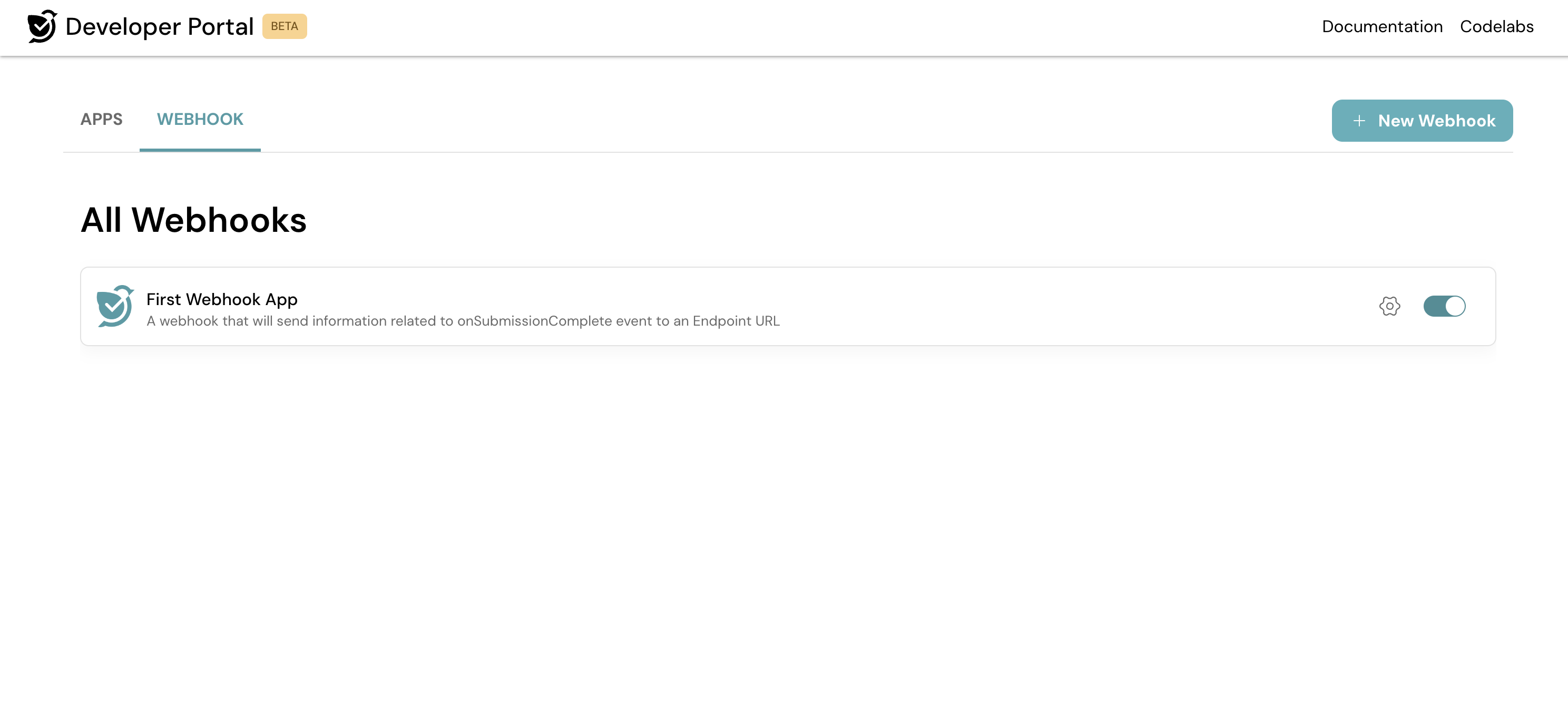
- Rate limiting is enforced on Global Webhooks. It restricts each event payload transmission to a maximum of 5000 occurrences per day within a single webhook.
- In simple terms, 5000 payload transmissions for one event per day per webhook
- In the body of the POST request sent to the endpoint URL, the data will be sent in a format similar to the one given below. Note that the event payload varies for each event. Below event payload is an example for onSubmissionComplete event.
{ { "eventType": "onSubmissionComplete", "ruleEvent": "SUBMISSION_COMPLETED", "objectType": "SUBMISSION", "data": { "id": 100000105, "time_taken": "3.00", "state": "COMPLETED", "device_type": "COMPUTER", "feedback": null, "ip": null, "location": null, "language": "en", "geo_info": {}, "created_at": "2023-12-20T08:31:18.496Z", "updated_at": "2023-12-20T08:31:18.650Z", "account_id": 100000011, "contact": { "email": "kjher@gmail.com", "full_name": "kjher", "last_name": "", "first_name": "kjher", "createddate": "12-20-2023", "id": 100014810 }, "score": 8, "meta_data": { "browser": "Chrome 120.0.0.0", "os": "macOS 10.15.7", "time_zone": "Asia/Calcutta", "browser_language": "en-GB" }, "survey": { "id": 100000060, "survey_type": "NPSChat", "name": "IHCL NPS" }, "folder": { "id": 100000011, "name": "General" }, "answers": { "100000103": { "answer": 8, "question": "How likely are you to recommend this product to a friend or colleague?", "question_type": "NPSScore", "question_tags": [], "question_id": 100000103, "skipped": false } }, "variables": { "variable_1": "56" }, "expressions": { "1001000001": "9.000000000000000" }, "channel": { "id": 100000532, "type": "LINK", "name": "Web Link Share", "status": "ACTIVE", "web_url": "https://3f8f-117-221-62-213.ngrok-free.app/s/IHCL-NPS/ntt-x7MchBF3QaiUfjoU3ytCvq" } }, "account_id": 100000011 } }
Congratulations on reaching the end of this comprehensive tutorial on Global Webhooks by SurveySparrow! We've covered the setup process, configurations, authentication methods, and event selection, providing you with a deep understanding of Global Webhooks.
If you have any lingering doubts or queries, we encourage you to connect with our vibrant developer community.
Alternatively, if you prefer direct assistance, our support team is ready to address your concerns. Drop us an email at support@surveysparrow.dev, and our dedicated support professionals will get back to you promptly.
Your success in implementing Global Webhooks is our priority, and we are here to ensure a smooth and enriching experience throughout your integration journey.
Happy webhook-ing!